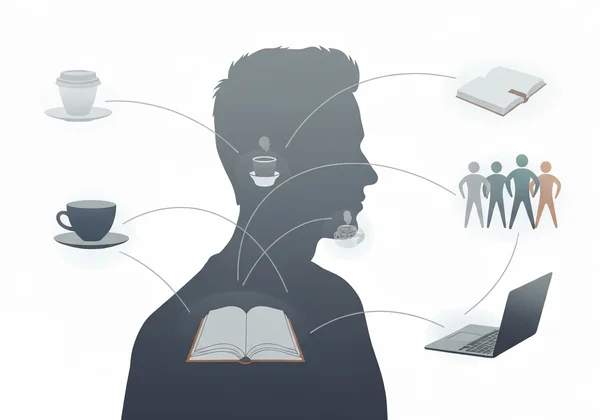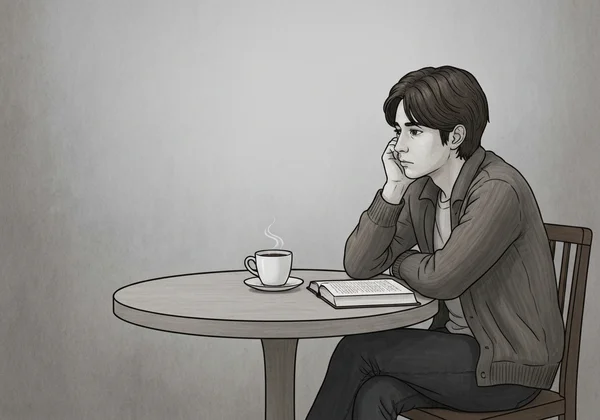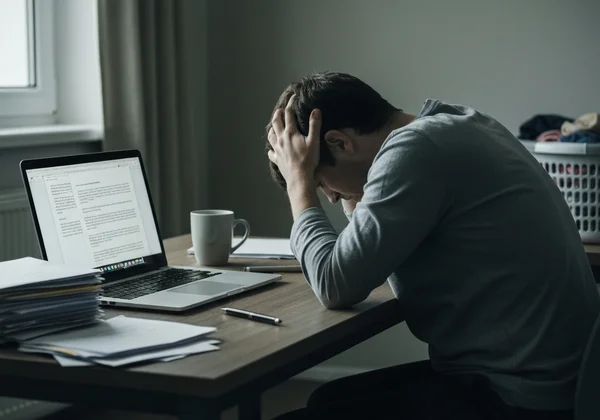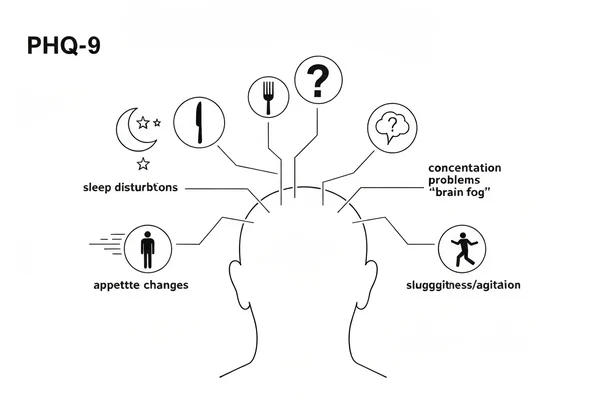PHQ-9 Symptoms in Daily Life: Anhedonia & Fatigue
Have you ever looked at the questions on a mental health screening and felt like they were speaking a different language? Terms like "anhedonia" or "psychomotor agitation" can feel clinical and distant. In reality, these are deeply human experiences that manifest in subtle yet significant ways in our daily lives. The PHQ-9 is a powerful tool for flagging these signs, but its true value is unlocked when you connect its questions to your reality. What does it actually feel like to experience these symptoms day-to-day?
Understanding this connection is the first step toward gaining clarity about your emotional health. It transforms a simple questionnaire into a mirror, reflecting your inner world and empowering you with self-awareness. If you're ready to see how these symptoms might be appearing in your life, you can get a clearer picture by taking a confidential screening.

Unpacking Anhedonia: When "Little Interest or Pleasure" Becomes Your Reality
One of the first questions on the PHQ-9 asks about a loss of interest or pleasure in doing things. This is the clinical definition of anhedonia, a core symptom of depression. It’s not just about feeling sad; it’s about the absence of joy where it once existed. This symptom can be confusing because it often creeps in slowly, draining the color from your world without you even noticing.
Anhedonia is more than just boredom. It’s a profound disconnect from the activities and people you once loved. The hobbies that brought you excitement now feel like chores, and the thought of engaging in them is met with indifference or even exhaustion.
How Anhedonia Manifests in Social Interactions and Hobbies
Have you found yourself canceling plans with friends more often, not because you’re busy, but because the thought of socializing feels overwhelming? This is a classic sign of anhedonia. Conversations may feel draining, and you might find it hard to muster the energy to laugh at a joke or feel connected to others. Hobbies that were once your escape—like reading, gardening, or playing music—can start to feel like obligations you can no longer fulfill. The joy they provided is replaced by a flat, empty feeling.
The Subtle Impact of Losing Joy in Daily Routines
Anhedonia also affects the small, everyday moments. The pleasure from a morning cup of coffee, the satisfaction of a completed task at work, or the simple comfort of watching your favorite show can all fade away. Food may taste bland, music might sound hollow, and even a beautiful sunset can fail to stir any emotion. This gradual erosion of small joys is one of the most insidious signs of depression, leaving you feeling detached and unfulfilled in your own life.

Decoding "Feeling Down, Depressed, or Hopeless": Core Emotional Shifts
Another key question on the PHQ-9 addresses feeling down, depressed, or hopeless. This is more than temporary sadness; it's a persistent emotional state that can cloud your perception of yourself, your life, and your future. While everyone experiences bad days, the feelings associated with depression are more pervasive and difficult to shake.
This emotional shift is a heavy blanket that settles over you, making it difficult to access positive emotions. Understanding the difference between a passing blue mood and the persistent weight of this symptom is crucial.
Recognizing Persistent Sadness vs. Fleeting Low Moods
A fleeting low mood might last for a few hours or a day, often triggered by a specific event like a bad day at work. You can usually still find moments of enjoyment, and the feeling lifts. Persistent sadness, however, lingers for weeks or more. It’s a constant companion that doesn’t require a specific trigger. It’s a sense of emptiness that is present even during what should be happy occasions, making it hard to feel genuinely content or at peace.
When Hope Fades: Understanding Chronic Hopelessness
Hopelessness is the belief that things will never get better. It’s a painful feeling that your struggles are permanent and that you are powerless to change your situation. This can manifest as pessimism about the future, a feeling of being trapped, or the belief that you’ll never feel happy again. When this feeling takes hold, it can paralyze you, making it difficult to take steps toward recovery because you genuinely believe nothing will help.
Beyond Tired: Understanding Depression and Fatigue
The PHQ-9 asks about feeling tired or having little energy. This isn't the kind of tiredness that a good night's sleep can fix. Depression and fatigue are deeply intertwined, creating a profound sense of exhaustion that affects both your body and mind. This all-encompassing weariness makes even small tasks, like getting out of bed or showering, feel monumental.
This fatigue is a heavy, leaden feeling that weighs you down. It’s not just about needing more sleep; it’s about a fundamental lack of energy and vitality that impacts every aspect of your day. To understand your own energy levels, you can start your PHQ-9 assessment anytime.
Physical vs. Mental Exhaustion: What's the Difference?
Physical exhaustion feels like your muscles are heavy and your body is slow. You might move more sluggishly and find physical activity incredibly draining. Mental exhaustion, on the other hand, is often described as "brain fog." It’s the feeling that your mind is wading through mud. Concentrating becomes difficult, making decisions feels impossible, and your memory may seem less sharp. Often, these two types of exhaustion occur together, creating a debilitating cycle.
How Fatigue Impacts Work, Productivity, and Daily Chores
At work, this deep fatigue can manifest as decreased productivity, difficulty focusing during meetings, and trouble meeting deadlines—all potential signs of depression at work. At home, the laundry piles up, dishes are left in the sink, and cooking a meal feels like running a marathon. This isn’t laziness; it’s a genuine symptom of an underlying emotional struggle. The inability to keep up with daily responsibilities can then fuel feelings of guilt and inadequacy.

"Feeling Bad About Yourself": Guilt, Worthlessness, or Failure
The PHQ-9 also screens for negative self-perceptions, asking if you’ve been "feeling bad about yourself—or that you are a failure or have let yourself or your family down." These feelings of guilt, worthlessness, and self-criticism are common and painful aspects of depression. Your inner voice can become relentlessly critical, replaying past mistakes and convincing you that you are fundamentally flawed.
This isn't just low self-esteem; it's an active, distorted internal narrative that erodes your self-worth. Recognizing when this inner critic has taken over is vital.
Unwarranted Guilt: Carrying Burdens You Don't Own
Depression can make you feel excessively guilty about things that are not your fault or blow minor mistakes completely out of proportion. You might blame yourself for others’ unhappiness, for not being productive enough when you’re exhausted, or for things entirely outside of your control. This unwarranted guilt is a heavy burden that can further deepen feelings of sadness and isolation.
Self-Criticism and Low Self-Esteem: Impact on Confidence
Constant self-criticism chips away at your confidence, making you second-guess your decisions and doubt your abilities. This can lead you to withdraw from challenges at work or in your personal life, reinforcing the feeling of being a failure. It creates a vicious cycle where low self-esteem prevents you from engaging in activities that could build your confidence back up.
Other PHQ-9 Symptoms in Real Life: Sleep, Appetite, Concentration & Movement
The remaining PHQ-9 questions cover other vital signs of how depression manifests physically and cognitively. These symptoms often work in tandem, creating a complex web that affects your overall well-being. Getting a baseline of these symptoms can be a helpful first step; a confidential online tool is available to help.
Sleep Disturbances: Too Much, Too Little, or Non-Restorative
Depression can severely disrupt your sleep patterns. For some, it causes insomnia—difficulty falling asleep, staying asleep, or waking up far too early. For others, it leads to hypersomnia—sleeping for excessively long periods but still waking up feeling unrefreshed. Either way, non-restorative sleep contributes heavily to daytime fatigue.
Changes in Appetite and Weight: Eating Too Much or Too Little
Your relationship with food can also change. Some people lose their appetite entirely, finding no pleasure in eating and subsequently losing weight without trying. Others may turn to food for comfort, leading to overeating and weight gain. These changes are not conscious choices but rather physiological responses to your emotional state.
Concentration Problems: "Brain Fog" at Work or Home
As mentioned with fatigue, difficulty concentrating is a hallmark symptom. This "brain fog" makes it hard to focus on a book, follow the plot of a movie, or stay on task at work. You might find yourself re-reading the same sentence over and over or forgetting what you walked into a room to do.
Sluggishness or Agitation: The Hidden Physical Signs
The PHQ-9 asks if you’ve been moving or speaking so slowly that other people could have noticed, or the opposite—being so fidgety or restless that you have been moving around a lot more than usual. The former is called psychomotor retardation, while the latter is psychomotor agitation. These are observable physical signs that your internal state is affecting your nervous system.

When to Take Action: Recognizing the Signs for Yourself or a Loved One
Understanding what PHQ9 questions mean in the context of daily life is the first step. The next is recognizing when these patterns are becoming persistent and concerning. It’s about seeing the difference between a bad week and a consistent decline in your well-being. A screening tool can provide valuable clarity, helping you organize your feelings into a clear, understandable format.
Is it Just a Bad Day, or Something More Persistent?
The key is duration and severity. Are these symptoms present more days than not for at least two weeks? Are they interfering with your ability to function at work, at school, or in your relationships? If the answer is yes, it’s a sign that something more is going on. It’s time to take your feelings seriously and consider seeking further insight. You can always take a free assessment to get a baseline.
Talking to a Loved One: Signs to Look For and How to Approach
If you recognize these signs in a friend or family member, it can be difficult to know how to approach them. Look for changes in their behavior: social withdrawal, neglect of personal appearance, persistent irritability or sadness, or frequent complaints of fatigue. When you talk to them, approach the conversation with empathy and without judgment. You could say, "I've noticed you haven't seemed like yourself lately, and I'm concerned. I'm here for you if you want to talk."
Understanding Your PHQ-9 Symptoms: The First Step Towards Well-being
Translating vague feelings of distress into specific, understandable symptoms is where the PHQ-9 truly shines. It empowers you to recognize how anhedonia, fatigue, hopelessness, and guilt manifest in your daily routines, marking a crucial step towards understanding and addressing your emotional health.
This knowledge gives you a language to describe your experience, whether to yourself, a loved one, or a healthcare professional. Remember, a screening is not a diagnosis, but it is a powerful starting point. To gain confidential, instant insight into your emotional well-being, start your PHQ-9 assessment today and take the first step on your journey to feeling better.
Frequently Asked Questions About PHQ-9 Symptoms and Depression
What is PHQ-9 and why is it used for depression screening?
The Patient Health Questionnaire-9 (PHQ-9) is a trusted, multipurpose tool used by clinicians and researchers worldwide to screen for the presence and severity of depression. It consists of nine questions based on the diagnostic criteria for major depressive disorder. It's used because it is quick, reliable, and provides a clear score that helps identify individuals who may need a more thorough mental health evaluation.
Can the PHQ-9 be used to diagnose depression?
No, it is very important to remember that the PHQ-9 is a screening tool, not a diagnostic tool. While a high score indicates that you may be experiencing significant depressive symptoms, only a qualified healthcare professional, such as a doctor or mental health therapist, can provide an official diagnosis after a comprehensive evaluation.
How often should I take the PHQ-9 if I'm experiencing symptoms?
If you are tracking your symptoms or undergoing treatment, a healthcare provider might recommend taking the PHQ-9 at regular intervals (e.g., every 2-4 weeks) to monitor progress. If you are using it for an initial self-assessment, taking it once to get a baseline is a great first step. You can use the results as a starting point for a conversation with a professional, and you can always check your score again later.
What does a high PHQ-9 score mean for my daily life?
A higher score on the PHQ-9 generally correlates with more severe symptoms, which likely means a greater impact on your daily functioning. As this article explains, it can affect your work, relationships, energy levels, sleep, and overall quality of life. Understanding your score can help you recognize just how much these symptoms are affecting you and validate your struggles.
Is the PHQ-9 reliable for understanding my symptoms?
Yes, the PHQ-9 is a well-validated and highly reliable screening instrument. It has been extensively studied and is considered a gold standard for depression screening in primary care and other settings. Its reliability makes it an excellent tool for gaining a structured and accurate snapshot of your symptoms over the past two weeks.